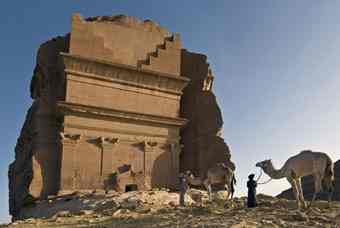On an arid plain in northern Saudi Arabia, the forlorn figure of Qasr al-Farid, "the Lonely Castle," rises four stories tall not far from the center of the ancient Nabataean city of Hegra.
 Despite its fanciful modern name, Qasr al-Farid is a tomb, albeit an unfinished one, cut out of a sandstone outcrop sometime in the first century A.D. It is one of 93 such monumental tombs carved here during the heyday of the Nabataeans.
Despite its fanciful modern name, Qasr al-Farid is a tomb, albeit an unfinished one, cut out of a sandstone outcrop sometime in the first century A.D. It is one of 93 such monumental tombs carved here during the heyday of the Nabataeans.
Beginning in the second century B.C., these Arabic-speaking nomads dominated the long-distance caravan trade that brought incense and aromatics from South Arabia to the Mediterranean, eventually growing wealthy and settling in a network of cities that featured Hellenistic architecture.
Besides developing a writing system that eventually became the Arabic script, they are best known for their capital, Petra, in present-day Jordan, famous for the facades that adorn entrances to buildings hewn from solid rock. But there is much more to the legacy of the Nabataeans than Petra.
Here, at an oasis at the foot of the Hedjaz Mountains, in what is today the Saudi Arabian province of al-Madinah, Nabataean elites and commoners left traces of life far from the capital.
Despite being the kingdom's second city in terms of size, Hegra was a remote outpost of Nabataean culture and power. Founded sometime in the second century B.C., the city was almost 300 miles from Petra, on the southern fringe of the kingdom.
Spread out over six square miles, Hegra (whose name means "rocky tract") was composed of a residential core of mud-brick buildings surrounded by sandstone outcrops wwith four necropolises featuring the kind of rock-cut tombs made famous by Petra.
But no one would mistake Hegra for Petra; the stark, open landscape is a sharp contrast to Petra's canyons, and even the style of Qasr al-Farid's facade—four carved pilasters with two on either side of its entrance, a departure from conventional Nabataean design—is a hint that things were different on the frontier.
Source: Archaeology Magazine